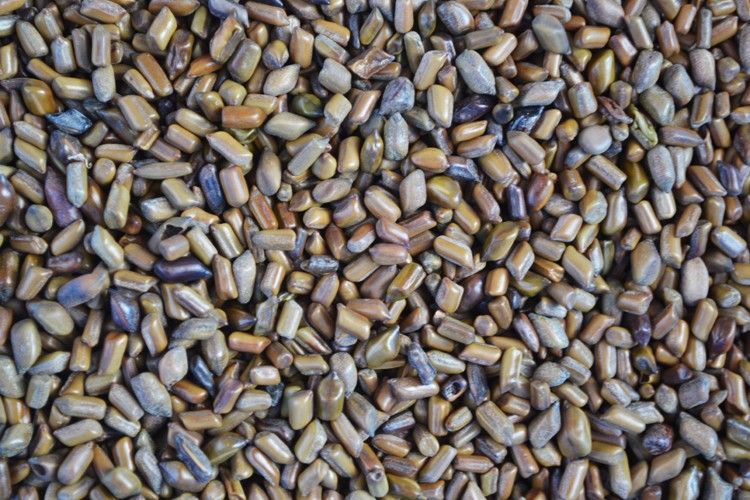Just as its name implies, cassia seed refers to the dried mature seeds of Cassia obtusifolia L. or Cassia tora L., which is a plant in the family Leguminosae. Other names also include cassia tora seed, Cao Jue Ming, seed of sickle senna, and Foetid Cassia Seeds. In China it is mainly produced in Anhui, Guangxi, Sichuan, Zhejiang, Guangdong and other places. The best collecting season is autumn when the fruits are ripe. And then it needs to dry in the sun, collect the seeds, and then remove the impurities. And it is usually used raw or fried.
Cassia obtusifolia is an annual suffruticose herbaceous plant, which grows between 0.5 to 2 meters. And there are many branches on the upper part. Pinnately compound leaf is alternate; petiole is 2 to 5cm; leaflets are 3 pairs; blade is obovate or obovate-oblong, 2 to 6cm long, 1.5 to 3.5cm wide, and with rounded apex and cuneate base. Flowers are axillary in pair and the top ones are acervate; peduncle is very short; pedicel is about 1 to 2cm; sepals are 5 and obovate; corolla is yellow, obovate, 12 to 15mm long, and with 5 petals and base with claws. Pod is slender, four edged, 15 to 20cm long, 3 to 4mm wide, and with 2 to 4cm stalk. Seeds are numerous, nearly in prismatic shape or sometimes slightly flat, light brown, bright, and with linear oblique groove on each side. It usually blooms from June to August and fruits from August to October. Habitats include hills, roadside, barren mountain, hillside, and woodland.
Cassia obtusifolia seeds contain anthraquinone compounds, cassiaside, mucus, proteins, sitosterol, amino acids and fatty oil. And anthraquinone compounds mainly include emodin, physcion, chrysophanol, aloe-emodin, obtusifolin, obtusin, chryso-obtusin, aurantio-obtusin and their glycosides and rhein. Cassia tora has almost the same chemical constituents except for the obtusifolin and its glycosides. In addition, it also contains chrysophanol-1-bgentiobiside.
CASSIA SEED BENEFITS
So, what is cassia seed good for? Actually it provides with a lot of health benefits. Clinical experiments show that its products, including cassia seed supplement, tea, extract, seed oil, and powder, can help on at least 4 major aspects. To begin with, in TCM remedies it is an essential herb for treating a variety eye infections, such as hot eyes, swelling and pain eyes, blurred vision, photophobia, excessive tearing, and more; then, cassia seed pillow can tremendously improve sleep quality by removing heat and soothing the nerves; furthermore, it can be used as a laxative to relax bowel and treat constipation; finally, it can also make herbal slimming tea that really work thanks to its purging activity, which can interfere with the absorption of fats and carbohydrates.

Cassia Seed
SELECTED HERBAL REMEDIES ON CASSIA SEEDS
In the Chinese Materia Medica, it is defined as salty and bitter in flavor and neutral, cool, and non-toxic in medicinal properties. And it acts on three meridians of liver, gall bladder and kidney. Basic functions include dispelling the wind, clearing heat, relieving internal fire, and removing dampness. Common cassia seed uses and indications are wind-heat type Common Cold, influenza, Acute Conjunctivitis, damp-heat jaundice, acute and Chronic Nephritis, morbid leucorrhea, scrofula, Carbuncle and boils, and Mastitis. Recommended cassia seed dosage is from 9 to 15 grams in decoction.
1. Jue Ming Zi San from Yin Hai Jing Wei (Essential Subtleties on the Silver Sea). It is used with Huang Qin (Scutellaria Baicalensis), Chi Shao (Red Peonies) and Mu Zei (Herba Equiseti Hiemalis) for the treatment of liver-heat induced hot red eyes, photophobia, and excessive tearing.
2. Jue Ming Zi Wan from Zheng Zhi Zhun Sheng (The Level-line of Patterns & Treatment). It combines with Ju Hua (Chrysanthemum Morifolium), Qing Xiang Zi (Celosia Seeds), Chong Wei Zi (Fructus Leonuri), etc. to treat headache and red eyes due to wind-heat attacking upward.
3. Jue Ming San from Yin Hai Jing Wei. It is formulated with Shan Zhu Yu (Asiatic Cornelian Cherry Fruit), Sheng Di Huang (Rehmannia), etc. to cure blurred vision and dim eyesight caused by liver-kidney yin deficiency.

![Diseases, Symptoms, tcm, [tcmwindow.com]](/uploadFile/adImg/2015/11/11/f5cbfcc0-4df5-4646-9b9a-f316651a0199.jpg)





